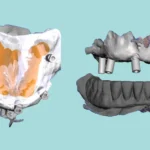Imagine, doctor, you’re on emergency rotation during your internship. A patient walks in, face swollen, struggling to open their mouth properly after a significant altercation. What’s the very first thing that springs to mind? A jaw fracture, of course. Mandibular fractures are among the common cases we encounter, and it’s absolutely crucial to interpret them correctly on radiographs.
Simply put, these fractures represent a break in the continuity of the mandibular bone. They can manifest as a single fracture or, quite often, as multiple fractures.
Radiographic Features: What to Look For
To quickly spot a fracture on a radiograph, you need to hone in on these specific details:
Location
Certain areas are particularly prone to fractures, such as:
-
The Angle of the mandible
-
The Neck of the ramus
-
The Anterior mandible
Often, the fracture line extends and connects with the periodontal ligament space of the teeth within the fracture zone.
Edge Characteristics
The edges of a fracture line are typically well-defined and distinct.
Shape
You might observe a fracture line that appears linear or jagged. Occasionally, it might not conform to a specific, identifiable shape.
Internal Structure
Here’s a vital point: the fracture line itself appears radiolucent (transparent to X-rays). However, if the two fractured bony segments overlap, that specific area will appear radiopaque (opaque to X-rays).
Number of Fractures
A fracture can be singular (single) or multiple. If two distinct fracture lines within the mandible separate the bone into three distinct parts, this is termed a segmental fracture.
Key Points in Diagnosis: A Quick Review
To ensure we don’t overlook anything, let’s recap the four essential radiographic signs of fractures:
-
The appearance of a radiolucent line.
-
Discontinuity of the cortical outline (a break in the smooth outer cortical bone).
-
A noticeable change in the trabecular pattern (the internal bone structure).
-
Deviation or displacement of the bony fragments.
Clinical Significance: Why This Matters
These fractures are far more than just lines on an X-ray; they represent a condition with serious implications:
-
They typically cause significant pain, swelling, malocclusion (improper bite), and difficulty with jaw movement.
-
There’s a substantial risk of infection or non-union (failure of the bone to heal) if not managed correctly.
-
Treatment may necessitate surgical intervention or intermaxillary fixation (wiring the jaws together).
-
There’s a significant potential for collateral damage to adjacent vital structures, such as nerves or teeth.
A Final Note
It’s crucial to remember, doctor, that we may need to employ more than one radiographic modality (such as panoramic X-rays, CBCT, or CT scans) to achieve an accurate diagnosis and formulate a sound treatment plan. However, and perhaps most importantly, the clinical examination and a thorough patient history remain the bedrock upon which we contextualize and interpret all our radiographic findings.





















